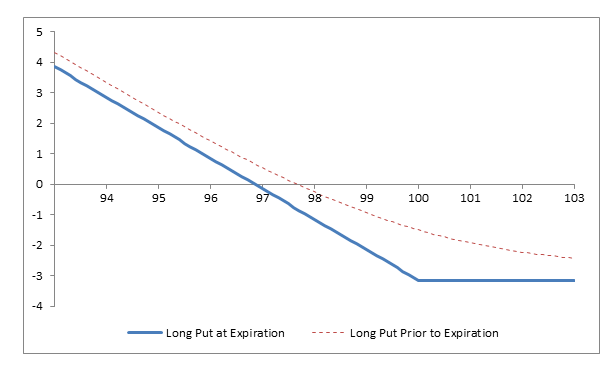Goal
To profit from an expected short-term price decline in a stock or market index.
Explanation
In return for paying a premium, the buyer of a put gets the right (not the obligation) to sell the underlying instrument at the strike price at any time until the expiration date. Speculators who buy puts hope that the price of the put will rise as the price of the underlying falls. Since stock options in the U.S. typically cover 100 shares, the put buyer in the example below pays $3.15 per share ($315 plus commissions) for the right to sell 100 shares of XYZ stock at $100 per share until the expiration date (usually the third Friday of the month). However, speculators typically do not want to have a short position in the underlying shares, so puts that are purchased to speculate are usually sold before the expiration date.
Example of long put - speculative
Buy 1 XYZ 100 Put at 3.15
Maximum profit
The maximum potential profit is equal to the strike price of the put minus the price of the put, because the price of the underlying can fall to zero.
Maximum risk
Risk is limited to the premium paid plus commissions, and a loss of this amount is realized if the put is held to expiration and expires worthless.
Breakeven stock price at expiration
Strike price minus premium paid.
In this example: 100.00 – 3.15 = 96.85
Profit/Loss diagram and table: Long 100 Put @ 3.15

| Stock Price at Expiration | 100 Put Value at Expiration | 100 Put Purchase Price | Profit/(Loss) at Expiration |
|---|---|---|---|
| 103 | 0 | (3.15) | (3.15) |
| 102 | 0 | (3.15) | (3.15) |
| 101 | 0 | (3.15) | (3.15) |
| 100 | 0 | (3.15) | (3.15) |
| 99 | 1.00 | (3.15) | (2.15) |
| 98 | 2.00 | (3.15) | (1.15) |
| 97 | 3.00 | (3.15) | (0.15) |
| 96 | 4.00 | (3.15) | +0.85 |
| 95 | 5.00 | (3.15) | +1.85 |
| 94 | 6.00 | (3.15) | +2.85 |
| 93 | 7.00 | (3.15) | +3.85 |
Appropriate market forecast
Buying a put to speculate requires a 2-part bearish forecast. The forecast must predict (1) that the stock price will fall so the put increases in price and (2) that the stock price decline will occur before option expiration.
Strategy discussion
Buying a put to speculate on a predicted stock price decline involves limited risk and two decisions. The maximum risk is the cost of the put plus commissions, but the realized loss can be smaller if the put is sold prior to expiration. The first decision is when to buy a put, because puts decline in price when the stock price remains constant or rises. The second decision is when to sell, because unrealized gains can disappear if the stock price reverses course and rises. Many investors who buy puts to speculate have a target price for the stock or for the put, and they sell the put when the target is reached or when, in their estimation, the target price will not be reached.
Impact of stock price change
Put prices, generally, do not change dollar-for-dollar with changes in the price of the underlying stock. Rather, puts change in price based on their "delta." Deltas of put options are negative, and at-the-money puts typically have deltas of approximately –.50. Therefore, a $1 rise or fall in stock price causes an at-the-money put to fall or rise by approximately 50 cents. In-the-money puts have deltas between –1.00 and –.50. Out-of-the-money puts tend to have deltas between –.50 and zero.
Impact of change in volatility
Volatility is a measure of how much a stock price fluctuates in percentage terms, and volatility is a factor in option prices. As volatility rises, option prices tend to rise if other factors such as stock price and time to expiration remain constant. As a result, long put positions benefit from rising volatility and are hurt by decreasing volatility.
Impact of time
The time value portion of an option’s total price decreases as expiration approaches. This is known as time erosion. Long puts are hurt by passing time if other factors remain constant.
Risk of early assignment
The owner of a put has control over when a put is exercised, so there is no risk of early assignment.
Potential position created at expiration
If a put is exercised, then stock is sold at the strike price of the put. If there is no offsetting long (or owned) stock position, then a short stock position is created. Furthermore, puts are automatically exercised at expiration if they are one cent ($0.01) in the money. Therefore, if a speculator wants to avoid having a short stock position when a put is in the money, the put must be sold prior to expiration.
Other considerations
When puts are purchased to speculate, it is assumed that the investor does not want to have a short stock position. In many cases, in fact, there is not sufficient equity in the account to cover the margin requirement for a short stock position. Therefore, it is generally necessary for speculators to monitor a long put position and to sell the put if the target price is reached or if the put is in the money as expiration approaches.
